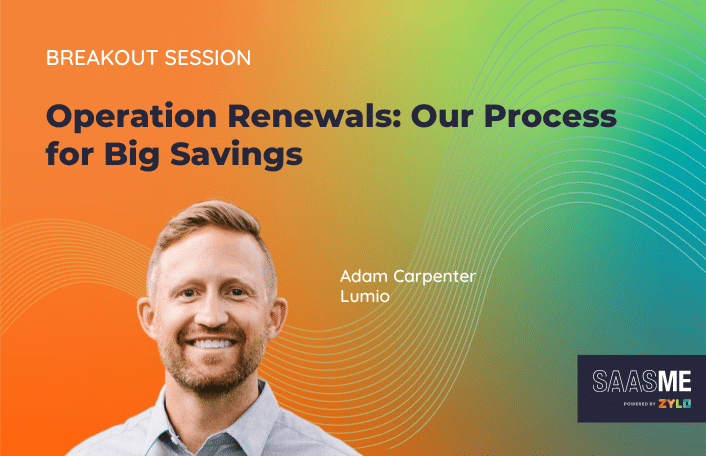06/28/2023
Table of Contents
Due to the proliferation of SaaS, the typical organization sees six new applications enter their SaaS portfolio every 30 days, resulting in an average of 204 renewals every year. Yet, it becomes impossible to effectively manage SaaS, especially renewals, if you don’t know what lurks in your tech stack.
This was precisely the issue at stake when Adam Carpenter joined Lumio as Sr. Program Manager of Enterprise Applications. Lumio formed out of a merger of five separate companies, each with its own software inventory.
Carpenter set out to determine each company’s existing software, initially finding around 150 applications. As he dug further, more SaaS appeared. He ultimately discovered 350 software applications between the different companies.
“We found out we had 11 learning management systems and three different software for CRM,” Carpenter said. “We had financial tools, we had expense management tools, and seven phone systems. We had to bring everything together and make it work through this merger, and there was a lot of duplicate software.”
Carpenter initially used spreadsheets to keep tabs on licenses and renewal terms, but the task quickly became unmanageable.
“We found this awesome tool called Zylo. It allowed us to get our arms around this new stack, and Zylo became the one source of truth for our contract management, vendor contact information, and utilization,” Carpenter said. “We were able to find duplicate software very quickly, immediate cost savings, and we were able to identify which users were in the systems and make decisions based on security and access.”
Once they got their tech stack in order, it was time to build a repeatable process around renewals. In a recent session of Zylo’s SaaSMe 2023 event titled Operation Renewals: Our Process for Big Savings, Carpenter spoke about how Lumio designed a governance strategy for renewals that allowed the organization to save millions on SaaS applications.
Check out Carpenter’s top three takeaways below.
1. Build a Calendar to Guide Renewal Decisions
After discovering all of their SaaS, Carpenter built a renewal calendar in Zylo to begin organizing and tracking renewal dates.
“It started out as a merging opportunity to remove duplicate technologies,” Carpenter said. “With the renewal calendar, we were able to find out when the contracts ended, where we need to move everything together on certain dates to renew contracts with one unified Lumio software, and be more visible about what we needed to do moving forward.”
Carpenter utilized Zylo’s automatic alerts to prepare for upcoming SaaS renewals. He initially set the renewals for 30 days, but quickly realized he needed more time.
“I learned that 30 days is not enough time — you need 60, 90, sometimes 120 days before the contract renewal,” Carpenter said. “And you need to hold these conversations in advance with your users, ask the right questions, and figure out what’s used and what’s not used. The best way to optimize and renew contracts is to start early.”
Ultimately, Lumio canceled over 25 duplicate applications and consolidated three CRMs into Salesforce, three Slack workspaces into one, four HRIS systems into Workday, among several other consolidations.
Lumio’s optimizations reduced expenditures by 22%, with an annual savings over $3MM.
2. Establish a Software Review Board
Next, Carpenter put together a review board of key stakeholders to establish a SaaS governance framework. The review board was tasked with setting a vision for the next 12 months.
“After we shared that vision and we understood where we wanted to go, we were able to empower our leaders by giving them dashboards and access to see this information, so they can better own and manage the software within their organizations,” Carpenter said.
The Lumio review board included:
- A chief administrative officer to serve as a product owner, make final decisions, sign contracts, and guide the team.
- A program manager to help with vendor relations and manage all of the contracts within Zylo.
- Subject matter experts who represented product, engineering, security, and finance teams.
3. Launch a Governance Strategy for Renewals
The review board met weekly to discuss renewal applications and employee requests for software. They created a form for employees to submit a request for new software, enabling the board to evaluate new requests as a group.
“As we began receiving more and more requests and also cleaning up and removing duplicate software, I started what we call the three Cs at Lumio, which is cancel, continue, and consolidate,” Carpenter said. “We created custom fields to categorize software into these areas, where we can start pulling reports to see what we need to cancel, and what we need to consolidate.”
For the contracts they planned to continue, Carpenter set alerts in the renewal calendar to provide ample time to come to the negotiating table fully prepared.
“Working with vendors, you’ll get a certain price for a one-year contract and different prices if you go two or three years,” Carpenter said. “We were able to pull some of these levers by moving some of our contracts from one or two years to three, and to aggregate cost savings over time and not spend so much upfront.”
Carpenter says their strategy enabled Lumio’s finance team to build out accurate cash flow budgets for each department and provide leaders with dashboards to own and maintain their software moving forward, all from a unified tech stack.
Managing SaaS Renewals with Zylo
As SaaS continues to overtake traditional software, businesses must establish a proactive process for managing SaaS renewals to reduce costs, avoid missed renewals, and negotiate better contract terms.
For the full story on how Lumio took control of SaaS renewals and saved millions, watch the on-demand session here. Learn more about how Zylo helps you renew software with confidence and without surprises here.

